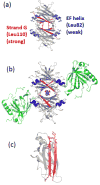Cerebrospinal Fluid Proteins as Regulators of Beta-amyloid Aggregation and Toxicity
- PMID: 29129937
- PMCID: PMC5679064
- DOI: 10.1002/ijch.201600078
Cerebrospinal Fluid Proteins as Regulators of Beta-amyloid Aggregation and Toxicity
Abstract
Amyloid disorders, such as Alzheimer's, are almost invariably late-onset diseases. One defining diagnostic feature of Alzheimer's disease is the deposition of beta-amyloid as extracellular plaques, primarily in the hippocampus. This raises the question: are there natural protective agents that prevent beta-amyloid from depositing, and is it loss of this protection that leads to onset of disease? Proteins in cerebrospinal fluid (CSF) have been suggested to act as just such natural protective agents. Here, we describe some of the early evidence that led to this suggestion, and we discuss, in greater detail, two CSF proteins that have garnered the bulk of the attention.
Keywords: Alzheimer’s disease; amyloid beta-peptides; apolipoprotein E; glycoproteins; transthyretin.
Figures

Similar articles
-
Independent information from cerebrospinal fluid amyloid-β and florbetapir imaging in Alzheimer's disease.Brain. 2015 Mar;138(Pt 3):772-83. doi: 10.1093/brain/awu367. Epub 2014 Dec 24. Brain. 2015. PMID: 25541191 Free PMC article.
-
Cerebrospinal fluid tau and amyloid-β1-42 in patients with dementia.Brain. 2015 Sep;138(Pt 9):2716-31. doi: 10.1093/brain/awv181. Epub 2015 Jun 30. Brain. 2015. PMID: 26133663
-
Biochemical stages of amyloid-β peptide aggregation and accumulation in the human brain and their association with symptomatic and pathologically preclinical Alzheimer's disease.Brain. 2014 Mar;137(Pt 3):887-903. doi: 10.1093/brain/awt362. Epub 2014 Feb 10. Brain. 2014. PMID: 24519982
-
Is ApoE ɛ 4 a good biomarker for amyloid pathology in late onset Alzheimer's disease?Transl Neurodegener. 2016 Nov 16;5:20. doi: 10.1186/s40035-016-0067-z. eCollection 2016. Transl Neurodegener. 2016. PMID: 27891223 Free PMC article. Review.
-
Cholesterol metabolism, apolipoprotein E, adenosine triphosphate-binding cassette transporters, and Alzheimer's disease.Curr Opin Lipidol. 2007 Jun;18(3):325-32. doi: 10.1097/MOL.0b013e32813aeabf. Curr Opin Lipidol. 2007. PMID: 17495608 Review.
Cited by
-
Calorimetric Studies of Binary and Ternary Molecular Interactions between Transthyretin, Aβ Peptides, and Small-Molecule Chaperones toward an Alternative Strategy for Alzheimer's Disease Drug Discovery.J Med Chem. 2020 Mar 26;63(6):3205-3214. doi: 10.1021/acs.jmedchem.9b01970. Epub 2020 Mar 18. J Med Chem. 2020. PMID: 32124607 Free PMC article.
-
Copper Toxicity Links to Pathogenesis of Alzheimer's Disease and Therapeutics Approaches.Int J Mol Sci. 2020 Oct 16;21(20):7660. doi: 10.3390/ijms21207660. Int J Mol Sci. 2020. PMID: 33081348 Free PMC article. Review.
-
Preparative Scale Production of Recombinant Human Transthyretin for Biophysical Studies of Protein-Ligand and Protein-Protein Interactions.Int J Mol Sci. 2020 Dec 17;21(24):9640. doi: 10.3390/ijms21249640. Int J Mol Sci. 2020. PMID: 33348885 Free PMC article.
-
A mechanistic model to predict effects of cathepsin B and cystatin C on β-amyloid aggregation and degradation.J Biol Chem. 2017 Dec 22;292(51):21071-21082. doi: 10.1074/jbc.M117.811448. Epub 2017 Oct 18. J Biol Chem. 2017. PMID: 29046353 Free PMC article.
-
Insights into the mechanism of cystatin C oligomer and amyloid formation and its interaction with β-amyloid.J Biol Chem. 2017 Jul 7;292(27):11485-11498. doi: 10.1074/jbc.M117.786558. Epub 2017 May 9. J Biol Chem. 2017. PMID: 28487367 Free PMC article.
References
Grants and funding
LinkOut - more resources
Full Text Sources
Other Literature Sources
Research Materials
